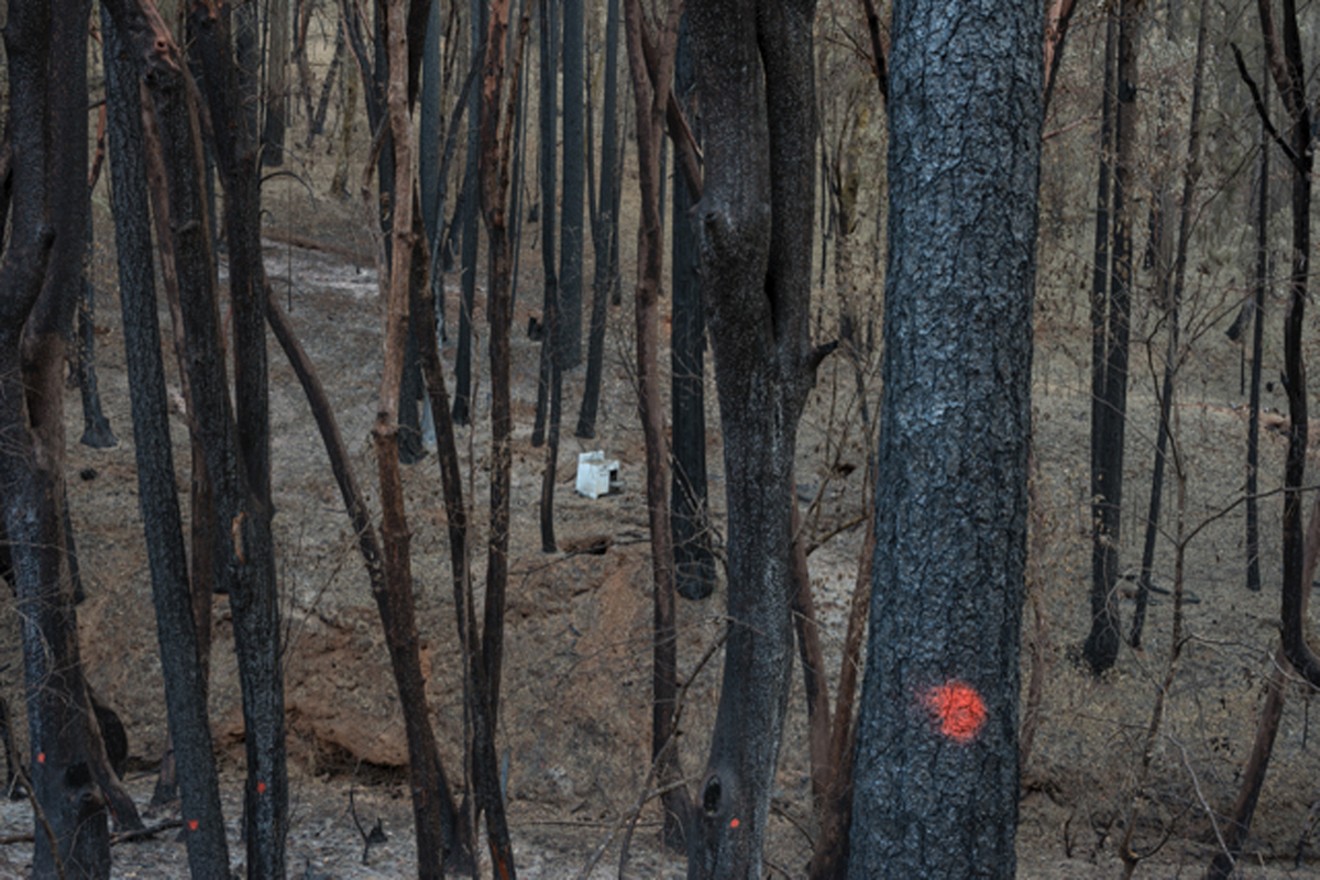Back in the 1980s, Canadian photographer Edward Burtynsky began capturing sweeping vistas in which industrial damage to the land was apparent. Early on, he used large-format analogue cameras with steel film, but he’s since turned to large-format digital cameras and Chromogenic printing. The photos in Edward Burtynsky: Selected Work, the first Robischon solo, capture the views from above, so that the scenery sprawls out before us.
Burtynsky’s genius lies in the way he juxtaposes the damage to the landscape with its visual majesty. “Carrara Marble Quarries #20” depicts the famous Italian quarry that has been excavated since ancient times because of the high quality of its white marble. The composition of the photo is classic and symmetrically balanced, with a dark peak in the center and two smaller mountains bracketing it, with lush greenery in the foreground. At first glance the scene is very beautiful — but then you notice that all of the mountains have been deeply gouged, clear cut of vegetation. The extensive areas of white, though superficially beautiful, are in fact scars.

"Carrara Marble Quarries #20" (left) and "Mount Adziza" (right), by Edward Burtynsky, photographs.
Courtesy of Robischon Gallery
The sensibility shifts subtly with the next solo, Elena Dorfman: Transmutations. This show is much larger than the Burtynsky display, not only filling the gallery’s expansive middle space, but extending into the viewing room in the back. Elena Dorfman, who divides her time between New York and Los Angeles, creates series of conceptual works; Transmutations is her latest. These landscapes explore Dorfman’s ancestry in Albania and the surrounding countries, where the artist has traveled extensively. She collages the photographic images into unified vistas, then applies metallic leaf and other materials to the resulting prints on paper mounted to Dibond.
Dorfman has written that she’s interested in conveying “physical impossibilities, conflicting perspectives, and rearranged geologies,” and intends to use these complex pictorial characteristics as metaphors for her own life and her specific genealogy.

"Transmutations #2 (Gold Dome)" (left) and "Transmutations #7" (right), by Elena Dorfman, altered photos.
Courtesy of Robischon Gallery
In addition to her printed works, Dorfman displays photo-based tapestries. Using digital jacquard looms, she transfers the details of the altered photos, metallic elements and all, onto cloth panels. In one of these, “Valbona 1,” a range of cloud-covered mountains have been pixilated with crisscrossing cotton threads, the shadows of the terrain picked out in places with metal threads. The result is amazing, something like a soft photo.
The largest of the four solos, Chuck Forsman: Hard Seasons, explores in some depth the work of an acknowledged Colorado master. Chuck Forsman was part of a group of artists interested in recording scenes that showed environmental damage. Colorado was one of the early centers of the New Topographic movement, and a founder, photographer Robert Adams, lived here. But if Forsman’s paintings are related to the movement, his photos exemplify it.
A photo series that shares the solo’s title takes up most of this exhibit. These photos are lyrical depictions of disasters, such as fires or slurry spills. With “Hard Seasons: Fire (stove),” Forsman is in a burned forest, and in the mid-ground, surrounded by bare tree trunks, is an abandoned white kitchen stove. The debris is poetically beautiful. In another work from the same series, the interior of a burnt-out car fills the foreground, the scorched forest visible through its open windows; the glass has melted into the steel frames of the seats and steering wheel. Other photos record the devastation of floods.
In the large back gallery, the solo concludes on a spectacular note with a half-dozen fairly monumental oil-on-canvas paintings done in the artist’s signature style. Forsman’s initial claim to fame were paintings like these; he used photos as studies for the paintings before he realized that the photos could stand on their own. Even so, Forsman is not a photo-realist, and instead takes a much more painterly approach to these works, expressing the elements of the pictures in conventionalized and simplified ways. In fact, the scenes he depicts aren’t even real, but imaginary. One unusual aspect of the paintings is that their overall shapes are based on the curved shapes of car windows: Forsman is making the point that we consider scenery mostly while we’re driving.
Looking at paintings like “Cold Storage” or “Strange Land,” I was reminded of the abstracted farmland and countryside views by Grant Wood that have been widely disseminated recently because of the retrospective of his brief career that just opened at the Whitney Museum of American Art in New York.
The last of the Robischon shows, ensconced in the window space up front, is Karen Kitchel: Austerity Measures. Karen Kitchel, who used to live in Colorado, is now based in California. She’s famous for her fanatically accurate depictions of wild grasses and weeds, including paintings in the collection of the Denver Art Museum. The five breathtaking “Terra Incognita” pieces she shows here are tall, thin horizontals, mirroring the proportions of the grasses themselves. In each are cascades of tall grasses against dark backgrounds, the blades folding over themselves, all carried out in shades of gold, gray and brown, indicating that the grasses are dead. This theme is even more pointed in the trio of “Drought Picture” paintings, which are each only a foot square but nonetheless crammed with renderings of dead blades of grass.
These four exhibits relate to one another aesthetically and conceptually on many different levels. Such sophisticated weaving of interconnections is a specialty of Robischon co-owner/director Jennifer Doran, who curated and designed the entire group.
Burtynsky, Dorfman, Forsman and Kitchel, through May 5 at Robischon Gallery, 1740 Wazee Street, 303-298-7788, robischongallery.com.













